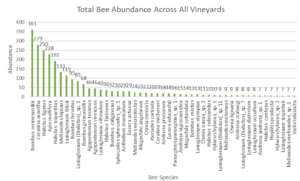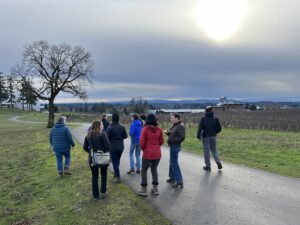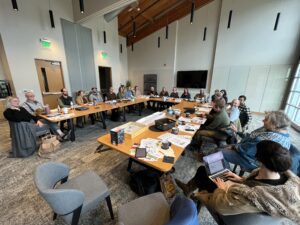Progress report for OW22-371
Project Information
The expansion of vineyards in the Pacific Northwest has the potential to negatively impact semi-natural areas rich in biodiversity that are key to pollinators and other organisms. This impact however, may be offset by vineyards willing to make investments in providing on-farm habitat vital for bees. While bee-habitat may not contribute to overall production, vineyards in the Western U.S. have shown a high level of adoption of farm practices of conservation concern, particularly when coupled to environmental certification initiatives. There is growing interest among vineyards to incorporate bee friendly farming into their practices, but relatively few acres certified to date. Our project looks to bridge the gaps between bee friendly vineyard practices, bee biodiversity, and public recognition of the efforts being made to protect bees through a mix of research and targeted outreach. Our team proposes to do this by evaluating existing on-farm habitat using new plant inventory and bee monitoring tools, promoting bee-friendly vineyards at wine tasting rooms through new Extension and outreach tools, and aiding the adoption of our habitat evaluation and bee friendly farming promotion tools beyond the project team through an on-farm Bee-Friendly Viticulture Field Day.
The project has two research objectives:
Objective 1: Evaluation of nectar and pollen resources in Oregon vineyards and compare it to top bee-plants found within the American Viticultural Areas (AVAs) where the vineyard is located.
Objective 2: Native bee monitoring on vineyards to establish a baseline for bee biodiversity from which to evaluate restoration efforts.
The project has three education objectives:
Objective 3: Developing a bee-friendly farm management plan for each cooperating vineyard based on the findings of objectives 1 and 2.
Objective 4: Create public outreach material and host public events on bee-friendly farming practices at the tasting rooms of cooperating vineyards.
Objective 5: Host Oregon's first Bee-Friendly Viticulture Field Day.
Cooperators
- - Producer
- - Technical Advisor (Educator and Researcher)
- - Producer
- - Producer
- - Producer
- - Producer
- - Producer
Research
Objective 1: Evaluation of nectar and pollen resources in Oregon vineyards
We hypothesize that vineyards contain a significant subset of important bee plants typically found within a region within uncultivated areas. In order to test this hypothesis, we propose a method for characterizing bee plant diversity that can be readily implemented by viticulturalists, crop consultants, and winery tasting-room patrons. The method will be developed through an iNaturalist Collection Project, which aggregates all iNaturalist observations of blooming plants within the boundaries of a given vineyard. Using this platform, photo-vouchers will be collected from April-October 2022 and 2023 from all flowering bee-attractive plants in vineyards and on semi-natural farm headlands. For each blooming plant species, a minimum of three photos will be obtained, including a leaf detail, a flower detail, and a zoomed out image showing the plant in its surroundings to facilitate plant identification (25). Photo-voucher records will be provided from three different sources: 1) bi-weekly surveys project staff, 2) daily records produced by farm staff and crop consultants, and 3) images collected by patrons of vineyard tasting rooms during either a spring (June) or summer (August) bioblitz event (described in detail under Education Plan). All observers will be instructed to accept the Family level machine-learning plant identification provided by iNaturalist, as accuracy at this level of taxonomic detail is typically accurate (26). All records will be reviewed by project staff to ensure correct plant identification to the genus or species level.
Records collected from the vineyards will be compared to regional plant data using methods modified from Dolezal et al. (27). We will develop a regional pool of bee-attractive plants within each of the American Viticultural Areas (AVAs) in the study area (there are a total of six AVAs in the Willamette Valley) by assembling a list of plants within each AVA using all contemporary records (i.e., since 2010) from Oregon Flora and iNaturalist. Since the later dataset lacks authoritative determinations, we will use it to the family-level. Next we will use plant-host data from the 2018-2020 Oregon Bee Atlas to identify specific plant genera within each AVA that either have consistently broad genera of bees associated with it, are associated with rare bees, or which have records for bees with narrow host ranges. We will compare bee-plant species richness and species evenness at each of the five vineyards and determine the number of important bee plants, found in the AVA area, that are missing at each vineyard.
Objective 2: Native bee monitoring
We predict that farms with a higher bee-plant diversity (objective 1) will also have more abundant and reproductively successful native bees. To test this hypothesis, but also to provide the producers with a metric for measuring the effectiveness of their overall bee conservation efforts, we will monitor for native bees across the season at all vineyards for two seasons. Past work to document the native bees of Oregon farm land conducted during the Oregon Bee Project Flagship Farm program relied on blue vane traps (28). While these traps are effective at detecting rare species, they result in high processing costs (29). An alternative approach that the Oregon State University Pollinator Health lab has been developing involves inexpensive and easy to process cavity nest blocks. The traps consist of bundles of cardboard straws, with three different diameters, housed in a PVC pipe and suspended on posts. Recently, these same traps were shown to be effective at differentiating between Michigan cherry and blueberry farms with and without flowering strips established to support bee populations (19). Moreover, the PI has established a taxonomic reference collection for the native bees that live in these straws, which will allow us to quickly identify the bees nesting in the straws at each farm. Finally, by counting the number of straws of each species at each location we will be able to estimate the relative reproductive rate for each species at each site. Bee nest traps will be placed throughout all 5 vineyard sites starting in early in the Spring. A minimum of 5 traps will be used at each vineyard. Traps will be removed in September and brought to OSU. Straws will be removed from traps and incubated at 29°C for up to 4 weeks. The emerging bees will be identified by a native bee taxonomic authority at Oregon State University (Lincoln Best). Species richness and abundance at each site will be compared to vineyard specific plant data.
Research Outcomes
Objective 1: Evaluation of nectar and pollen resources in Oregon vineyards
We expanded participation in our pilot from 7 vineyards from the time of the last update to 23 as of April 1, 2024; an increase of three fold from the last report.
A total of 1,655 plant records were collected from seven vineyards across crop headlands, a four-fold increase in the number of observations from a year ago. The total number of plant species has yet to be determined as observations span a range of taxonomic levels of determination, including plant family, genus and species. The following 23 vineyards have active iNaturalist projects (linked, and the number of flowering species detected as of 30 April 2024).
Abacela Vineyards and Winery (25 species of plants identified - joined in 2024): https://www.inaturalist.org/projects/abacela-vineyards-and-winery
Abbey Road Farm (9 species of plants identified - joined in 2024): https://www.inaturalist.org/projects/abbey-road-farm
Abbott Claim Vineyards (40 species of plants identified): https://www.inaturalist.org/projects/abbott-claim-vineyard
Antica Terra (31 species of plants identified - joined in 2024): https://www.inaturalist.org/projects/antica-terra
Brooks Winery and Vineyard (30 species of plants identified - joined in 2023): https://www.inaturalist.org/projects/brooks-winery
Crawford Beck Vineyard (10 species of plants identified - joined in 2024): https://www.inaturalist.org/projects/crawford-beck-vineyard
Domaine Willamette at Bernau Estate Vineyard (60 species of plants identified - joined in 2023): https://www.inaturalist.org/projects/domaine-willamette-bernau-estate-vineyard
Fairsing Vineyard (53 species of plants identified - joined in 2023): https://www.inaturalist.org/projects/fairsing-vineyard
Fennwood Vineyard (18 species of plants identified - joined in 2023): https://www.inaturalist.org/projects/fennwood-vineyard
King Estate Winery (118 species of plants identified - joined in 2023): https://www.inaturalist.org/projects/king-estate-winery-vineyard
Laughlin Road Vineyard (27 species of plants identified - joined in 2023): https://www.inaturalist.org/projects/laughlin-road-vineyard
Lumos Wine Company (5 species of plant identified - joined in 2024): https://www.inaturalist.org/projects/lumos-wine-company
MonksGate Vineyard (32 species of plants identified - joined in 2023): https://www.inaturalist.org/projects/monksgate-vineyard
Montinore Vineyard (18 species of plants identified): https://www.inaturalist.org/projects/montinore-vineyard
Sokol Blosser (102 species of plants identified): https://www.inaturalist.org/projects/sokol-blosser-winery-flowering-plants-and-pollinators
Soter Vineyard (68 species of plants identified): https://www.inaturalist.org/projects/soter-vineyards-plants-and-pollinators
Three Wives Vineyard (41 species of plant identified - joined in 2024): https://www.inaturalist.org/projects/three-wives-vineyard
Tidarstar Vineyard (6 species of plant identified - joined in 2024): https://www.inaturalist.org/projects/tidalstar-vineyard
Walnut Ridge Vineyard (63 species of plants identified): https://www.inaturalist.org/projects/walnut-ridge-vineyard-plants-and-pollinators
Wild Azalea Vineyard (7 species of plant identified - joined in 2024): https://www.inaturalist.org/projects/wild-azalea-vineyard
Willamette Valley Vineyard (94 species of plants identified): https://www.inaturalist.org/projects/willamette-valley-vineyard-turner
Winter's Hill Estate Vineyards (86 species): https://www.inaturalist.org/projects/winter-s-hill-estate-vineyard
Youngberg Hill Inn & Winery (2 species of plant identified - joined in 2024): https://www.inaturalist.org/projects/youngberg-hill-inn-winery
These plant records were compared to a regional pool of bee-attractive plants within the Willamette Valley American Viticultural Areas (AVAs) from plant-host data extracted from the 2018-2020 Oregon Bee Atlas to identify specific plant genera within each AVA that either have consistently broad genera of bees associated with it. Using a R-Markdown script we provided each grower an output identifying which high value bee plants (i.e., plants that attract a large number of bee species) they currently have on their farm, as well as the top plants they could add to attract the broadest range of bees (see attachment for example from Montinore Vineyards). We modified the R-Markdown script from last year after feedback from the advisory committee (see under Products below).
Objective 2: Native bee monitoring
We installed 8-12 cavity nest blocks across six of the vineyards from April-September 2022 and 2023. These nest blocks were stored at 4C for three months to simulate winter conditions and are currently in the process of being incubated at 32C to cause bees to emerge in order to identify the bees to species. These specimens will be identified in 2024.
In addition we collected 2,627 bee specimens from host plants at 6 vineyards in 2022 and 11 vineyards in 2023, which will enable us to compare the bee community as predicted from our database (Objective 1) to the community as estimated from sampling at each vineyard. The bees have been identified by taxonomist Lincoln Best and we estimate to have 135 total bee species. Seven common species of bee (Bombus vosnesenskii, Ceratina acantha, Halictus ligatus, Apis mellifera, Halictus tripartitus, Melissodes lupinus, and Lasioglossum titusi) comprised 46% of the bees collected (Figure 1) and over 3/4 of the species detected were sampled 10 or fewer times. This survey effort comprises the largest done in commercial vineyards in the Western U.S.
Figure 1. Display of total bee abundance by species across 15 sampled vineyards (only bee species identified more than 7 times are shown on the graph).
Education and Outreach
Participation Summary:
No data has been collected to date.
We held a day long producer+professional meeting on January 10, 2023 with all participants at Stoller Vineyard on January 10, 2023. We held a second meeting on August 1, 2024 at Willamette Valley Vineyards in conjunction with a field day organized by LIVE (Low Input Viticulture and Enology). Our last producer+professional meeting was on January 4, 2024 at the OSU Yamhill County Extension office. We hosted five field tours of various aspects of pollinator habitat installation (https://www.oregonbeeproject.org/bee-friendly-wine-grower-tour). In addition there were a total 27 site visits to each vineyard in 2022 and 42 visits in 2023. A listserv was also established with 25 separate vineyards to improve communication among vineyard participants. Also, tabling to recruit new growers occurred at the Oregon Wine Symposium (February 14 and 15, 2023, and February 13 and 14, 2024) and at the annual meeting of LIVE (March 29-30, 2023 and March 20, 2024).
Information Products
- Oregon Bee Friendly Wine (Conference/Presentation Material)


